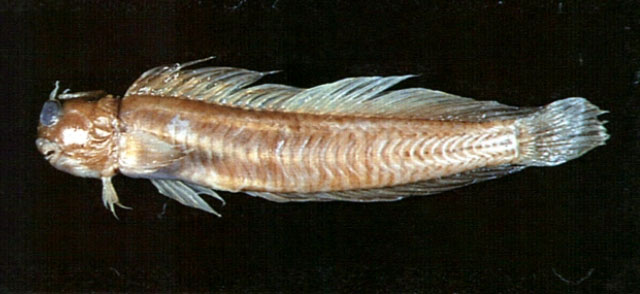| Blenniidae (Combtooth blennies), subfamily: Salariinae |
| 7 cm SL (male/unsexed); 5.5 cm SL (female) |
|
demersal; marine; depth range 0 - 1 m |
| Western Pacific: Hsiao-liu-chiu Island, off southwestern Taiwan; south to Kur Island, Indonesia. |
|
Dorsal spines (total): 12-14; Dorsal soft rays (total): 19-21; Anal spines: 2; Anal soft rays: 21-23. Dorsal fin XII-XIV, 19-21; membrane between spinous and segmented-ray portions notched deeper than half length of first segmented ray; membrane from posteriormost ray beginning from between dorsal edge of caudal peduncle at caudal-fin base (rarely) to dorsal edge of caudal fin up to 18% caudal-fin length in specimens ? 3 cm SL; anal fin II, 21-23 (23 only in males); pectoral-fin rays 13-14; vertebrae 10+27 to 30 = 37 to 40 (rarely 40); lacking nape cirrus; orbital cirrus simple, rarely a single branch or a few short, fine filaments at tip, typically shorter than orbital diameter; nasal cirrus simple, relatively long (typically half orbital diameter); lateral line canal continuous anterodorsally with simple pores (no vertical pairs), extending posteriorly to between verticals from bases of 6th and 9th dorsal-fin spines (usually to between verticals from 7th and 8th spines), then continuing posteriorly and posteroventrally as series of 1-6 (rarely 1 or 6) short, disconnected, horizontally bi-pored canals/tubes in skin; posteriormost tube area below and between verticals from bases of 7th spine and second segmented dorsal-fin ray (rarely posterior to vertical from 12th spine); mandibular pores 3-5; lacking posterior canines; ventral margin of upper lip and dorsal margin of lower lip entire; both sexes from ?3 cm SL with well-developed, fleshy, blade-like crest on dorsal part of head; crest of females comparatively smaller than males’; spinous portion of dorsal fin dusky, crossed by several diagonal, paler-dusky stripes with dark margins; segmented ray portion faint dusky with numerous dark pinstripes coursing length of fin, stripes coalescing into reticular pattern posteriorly. Male max. size ca 7 cm SL; female max. size ca 5.5 cm. |
| Adults occur in tide pools and close to edge of rocky shores at low tide. Oviparous. Eggs are demersal and adhesive (Ref. 205), and are attached to the substrate via a filamentous, adhesive pad or pedestal (Ref. 94114). Larvae are planktonic, often found in shallow, coastal waters (Ref. 94114). |
|
Least Concern (LC); Date assessed: 27 March 2009 Ref. (130435)
|
| harmless |
|
Museum: Nusa Laut, USNM 210953. Ambon, ZMA 120.378. Haruku, RMNH 20338, 20763. Kur I., ZMA 120.379. Karakelang I., ZMA 120.375. Sula Besi I., ZMA 120.377. Salebabu I., ZMA 120.376. Sorong, Irian Jaya, ANSP 168866 (Ref. 9962). With an Indonesian distribution from Papua and Moluccas (Ref. 47567, 90102). |
Source and more info: www.fishbase.org. For personal, classroom, and other internal use only. Not for publication.

